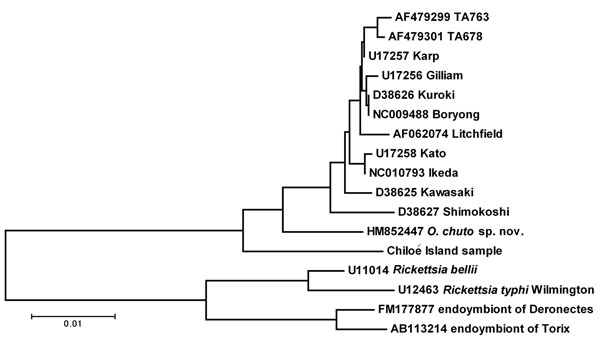Volume 17, Number 9—September 2011
Research
Endemic Scrub Typhus–like Illness, Chile
Figure 3

Figure 3. Evolutionary relationships of Chiloé Island sample compared with other isolates of Orientia tsutsugamushi, with O. chuto sp. nov. and with taxa from Rickettsia, determined by the method of neighbor joining (15). The tree is drawn to scale; scale bar indicates nucleotide substitutions per site. Numbers on branches represent percentage of 1,000 bootstrap replicates that include the enclosed clade. Entries on the tree are identified by GenBank accession number and isolate name.
References
- Walker DH, Raoult D. Introduction to rickettsioses and ehrlichioses. In: Mandell GL, Bennett JL, Dolin R, editors. Principles and practices of infectious diseases, 6th ed. Philadelphia: Churchill Livingstone; 2005. p. 2284–2318.
- Laval E. Historical review about the assistance to infectious diseases patients in Santiago, Chile, before the creation of Hospital Dr. Lucio Córdova. Rev Chilena Infectol. 2001;18:156–64.
- Enfermedades producidas por rickettsias: tifus exantemático y murino. Departamento de Epidemiología MINSAL. November, 1998 [cited 2011 Jul 5]. http://epi.minsal.cl/epi/html/public/tifusexen.htm
- Kelly DJ, Fuerst PA, Ching W-M, Richards AL. Scrub typhus: the geographic distribution of phenotypic and genotypic variants of Orientia tsutsugamushi. Clin Infect Dis. 2009;48:S203–30. DOIPubMedGoogle Scholar
- Izzard L, Fuller A, Blacksell S, Paris D, Richards A, Aukkanit N, Isolation of a novel Orientia species (O. chuto sp. nov.) from a patient infected in Dubai. J Clin Microbiol. 2010;48:4404–9. DOIPubMedGoogle Scholar
- Ghorbani RP, Ghorbani AJ, Jain MK, Walker DH. A case of scrub typhus probably acquired in Africa. Clin Infect Dis. 1997;25:1473–4. DOIPubMedGoogle Scholar
- López Del PJ, Abarca VK, Azócar AT. Evidencia clínica y serológica de rickettsiosis canina en Chile. Rev Chilena Infectol. 2007;24:189–93.PubMedGoogle Scholar
- Labruna MB, Ogrzewalska M, Moraes-Filho J, Lepe P, Gallegos JL, López J. Rickettsia felis in Chile. Emerg Infect Dis. 2007;13:1794–5.PubMedGoogle Scholar
- Richards AL, Soeatmandji DW, Widodo MA, Sardjono TW, Yanuwiadi B, Hernowati TE, Seroepidemiological evidence for murine and scrub typhus in Malang, Indonesia. Am J Trop Med Hyg. 1997;57:91–5.PubMedGoogle Scholar
- Isolation of. Moraxella canis from an ulcerated metastatic lymph node. J Clin Microbiol. 2000;38:3870–1.Vaneechoutte M, Claeys G, Steyaert S, De Baere T, Peleman R, Verschraegen G.PubMedGoogle Scholar
- Altschul SF, Gish W, Miller W, Myers EW, Lipman DJ. Basic local alignment search tool. J Mol Biol. 1990;215:403–10.PubMedGoogle Scholar
- Tamura K, Dudley J, Nei M, Kumar S. MEGA4: Molecular Evolutionary Genetics Analysis (MEGA) software version 4.0. Mol Biol Evol. 2007;24:1596–9. DOIPubMedGoogle Scholar
- Kikuchi Y, Fukatsu T. Rickettsia infection in natural leech populations. Microb Ecol. 2005;49:265–71. DOIPubMedGoogle Scholar
- Kikuchi Y, Sameshima S, Kitade O, Kojima J, Fukatsu T. Novel clade of Rickettsia spp. from leeches. Appl Environ Microbiol. 2002;68:999–1004. DOIPubMedGoogle Scholar
- Saitou N, Nei M. The neighbor-joining method: a new method for reconstructing phylogenetic trees. Mol Biol Evol. 1987;4:406–25.PubMedGoogle Scholar
- Tamura K, Nei M, Kumar S. Prospects for inferring very large phylogenies by using the neighbor-joining method. Proc Natl Acad Sci U S A. 2004;101:11030–5. DOIPubMedGoogle Scholar
- Jiang J, Chan T-C, Temenak JJ, Dasch GA, Ching W-M, Richards AL. Development of a quantitative real-time polymerase chain reaction assay specific for Orientia tsutsugamushi. Am J Trop Med Hyg. 2004;70:351–6.PubMedGoogle Scholar
- Villagrán-Mella R, Casanueva ME, Parra LE. Mites in the parenchyma of Juncus procerus in marshy wetlands in the Bio Bio region, Chile. Gayana (Concepción). 2005;69:22–6.
- Sielfeld W. Annelida, Hirudinea. Guías de Identificación y Biodiversidad de Fauna Chilena. In: Apuntes de Zoología, Universidad Arturo Prat, Iquique, Chile; 2002.
Page created: September 06, 2011
Page updated: September 06, 2011
Page reviewed: September 06, 2011
The conclusions, findings, and opinions expressed by authors contributing to this journal do not necessarily reflect the official position of the U.S. Department of Health and Human Services, the Public Health Service, the Centers for Disease Control and Prevention, or the authors' affiliated institutions. Use of trade names is for identification only and does not imply endorsement by any of the groups named above.